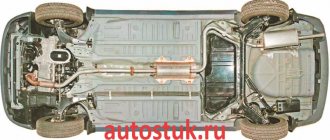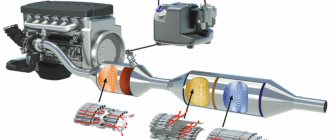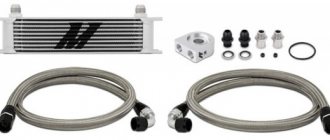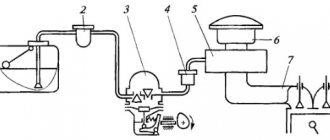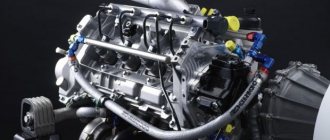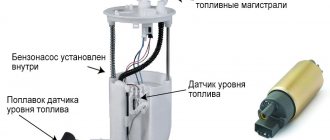What is Vanos in an engine?
Cutaway view of the engine showing the “double” vanos
Variable Nockenwellen Steuerung is translated from German as variable control of the engine camshafts. BMW engineers came up with this system. VANOS is essentially a variable valve timing system. Its peculiarity is that it is capable of changing the position of the camshafts in relation to the crankshaft. Thus, the phases of the gas distribution mechanism (GRM) are regulated. This regulation can occur in the range from 6 degrees advance to 6 degrees retard relative to top dead center.
Symptoms for replacing Vanos
- High fuel consumption;
- Loud work of Vanos;
- Stalling engine when cold;
- Heavy set of revolutions;
- Loss of traction during acceleration;
- Floating speed on a cold engine;
- Reduced torque and, as a result, poor traction, especially at the “lower” range up to 3000 rpm.
- If you notice any of the symptoms on your car, contact a service center for diagnostics.
How it works and what it consists of
VANOS is located between the camshaft and the drive gear. Its design is relatively simple. The main part of the system is the pistons, which change the position of the camshafts, thereby changing the valve timing. These pistons interact with the camshaft gears using a toothed shaft that connects to the piston. The movement of these pistons is ensured by oil pressure.
The principle of operation of oil pistons that regulate the operation of the gas distribution system
The design includes a special solenoid valve, the operation of which is controlled by the electronic engine control unit (ECU). Information from camshaft position sensors is taken as input data. Thanks to this sensor, the current angular position of the shafts is determined. The received data is then sent to the ECU to compare the received value with the specified angle.
Thanks to these changes in the position of the camshafts, the valve timing changes. As a result, the valves either open a little earlier than expected, or a little later than in the original position of the shafts.
Advice for BMW owners
If there is a distinct, constant knocking noise under the hood, a noticeable decrease in engine power and problems with idling, you will have to remove and disassemble the vanos valve. Any motorist can do this using a standard set of tools.
You can check the degree of wear by simply pressing in the control piston. If it sinks in smoothly and is pushed back by the spring, it will be enough to replace the O-rings.
Otherwise, it is necessary to sand the element itself and the cylinder or completely replace the moving element. Solving problems with the Vanos solenoid valve should begin by checking the integrity of the wiring . Its restoration is often a sufficient solution.
How the system works
BMW currently uses fourth-generation variable camshaft control (VANOS) technology in its engines. It is worth noting that the first generation of this technology was called Single VANOS. In it, only the intake camshaft was subject to regulation, and the exhaust phases were changed discretely, i.e. in leaps and bounds.
First generation or “single” Vanos
The essence of the work of such a system was this. The position of the intake camshaft was adjusted in accordance with engine speed and data from the accelerator pedal position sensor. If a small load was applied to the engine (low speed), then the intake valves began to open later, which, in turn, makes the engine idle smoother.
Early opening of the intake valves at medium engine speeds allows increasing the amount of torque, as well as improving the circulation of exhaust gases in the combustion chamber, which, in turn, reduces overall fuel consumption and exhaust toxicity. High engine speeds cause the intake valves to open later, resulting in maximum power. In the first few minutes after the engine starts, the system activates a special mode, the essence of which is to reduce the warm-up time as much as possible.
Second generation VANOS (also called “vanos vanos” or “double vanos”)
Nowadays the so-called Double Vanos is used. Unlike the “single-vane system”, the operation of the intake and exhaust camshafts is regulated in a double one, and their control occurs more smoothly, without jerking. Thanks to the use of the updated system, it was possible to significantly increase the torque and power of the engine throughout its entire speed range. Also, according to the BiVanos operating scheme, a small part of the exhaust gases can be re-burned in the combustion chamber, which, in turn, leads to an increase in the environmental friendliness of the engine.
Now all cars of the German brand use the fourth generation Vanos system. The key feature of this version is that it uses Vanos intake/exhaust camshaft gears. BMW engineers have made the system more compact - now the entire actuator is located in the timing sprockets themselves. Well, in general, the fourth generation of the system is similar in principle to Single Vanos.
Problems with the VANOS system
Modern BMW gasoline engines are equipped with VANOS variable valve timing system. Using the system allows you to achieve uniform engine operation at idle, improving torque characteristics throughout the entire speed range. Regardless of the vehicle's speed, the engine receives better performance and fuel efficiency.
Currently, BMW engines are equipped with the Doppel-VANOS system, in which the VANOS system actuators are located on both camshafts of the timing mechanism. The actuators are controlled by oil pressure, which is modulated by solenoid valves installed in the front of the engine.
The occurrence of problems in the VANOS system is caused by high temperature operating conditions of BMW engines, due to environmental requirements for modern gasoline engines, low quality motor oils used, as well as untimely engine maintenance. Due to the oil coking process, narrow oil channels become clogged with deposits, and the control oil pressure is no longer sufficient for the effective operation of the actuators. An error is recorded in the engine control unit, the Check Engine light comes on, or the message “reduced power” appears on the on-board computer.
Typical BMW VANOS problems
Typical faults and their symptoms
- Destruction of sealing rings. We are talking about oil piston rings that regulate the position of the camshafts. Due to numerous factors - high/low temperature, various harmful substances that get on the rubber, the latter begins to lose its elastic properties over time and crack. It is because of this that the tightness inside the mechanism disappears.
- Wear of washers and bearings. The oil pistons are designed with metal bearings and washers. Over time, they also begin to deform, since initially they have a small margin of safety. You can find out that you need to change the bearing/washer in the VANOS system by listening to the engine - you can hear an unpleasant, sharp metallic noise.
- Chips and dirt on flanges and pistons. We are talking about deformation of metal parts. This could be due to a rather aggressive driving style, low quality oil/gasoline, or simply high mileage. Chips and scuffs form on the front edge of oil pistons or gas distribution shafts. As a result, there is a loss of power/torque and unstable engine operation in idle mode.
If the car’s engine begins to vibrate strongly at idle, rather poor acceleration is noticed throughout the entire speed range, increased fuel consumption appears, and metallic sounds occur when the engine is running, then most likely the VANOS system requires urgent attention. A clear sign of poor performance are problems with starting the engine, spark plugs and detonation.
VANOS service
With regular technical inspection, all potential problems with the unit are caught and resolved at an early stage, so prevention is the best way to save money in your wallet. Ignoring the above symptoms costs yourself more. After all, VANOS interacts closely with the engine, and malfunctions of the unit lead to engine malfunctions in a chain reaction.
Timely cleaning and replacement of unit consumables keeps engine performance at the level of a freshly purchased car. So it’s better to treat this product of technical progress with due attention, and not fall for BMW’s tricks, replacing the entire unit because of a torn rubber band.
Repairing VANOS today is impractical; in most cases it is replaced.
BMW World Technical Center has significant experience in repairing the VANOS system on BMW with engines of the series: M52, M54, M62, N46. Please note that on engines N52, N53, N54, N62 and N63 only VANOS replacement is carried out; in other cases, repairs are possible, but this issue must be resolved with a specialist who, after diagnosing the internal combustion engine, will offer you the optimal solution to fix the problem with Vanos in your BMW.
We recommend the following sequence of actions in case of problems/malfunctions with the VANOS system:
- Flushing the engine lubrication system with a special cleaner to dissolve deposits in the oil channels.
- Changing engine oil with oil filter.
- Washing VANOS solenoids on an ultrasonic stand.
- Flushing or replacing VANOS check valves.
- Resetting adaptations and corrections of the engine control unit.
- Repeated diagnostics after 100 km.
Pros and cons of VANOS
Needless to say, the system turned out to be very successful in terms of squeezing maximum potential out of the engine, as well as the efficiency and environmental friendliness of its operation. But, as often happens, the big advantages turned into no less impressive disadvantages. VANOS seriously reduces the reliability and durability of the engine. At the same time, solving problems associated with this system costs a pretty penny.
Destruction of O-rings
The weakest point is the sealing rings of the oil pistons, which regulate the position of the camshafts. High temperatures and aggressive chemicals destroy the rubber material of these rings. The engine seems to be losing strength, requiring increasingly higher speeds to produce a certain power. And what’s most unpleasant is that BMW does not change these rings separately, only the VANOS unit completely. We have to look for alternatives and turn to unofficial service stations.
Wear of washers and bearings
And again, oil pistons - their bearings and washers are not made of the strongest metal, so over time the VANOS unit begins to perform its duties worse. Plus, the sound of the engine is mixed with an unpleasant, sharp metallic noise. Once again BMW does not offer any separate bearings! Therefore, those who do not want to shell out several tens of thousands of rubles for a new unit should order them from third-party manufacturers.
Chips and dirt on flanges and pistons
With an aggressive driving style, contamination in oil and gasoline, and simply a fairly high mileage, you may encounter problems with deformation of the metal parts of the block. Chips and scuffs appear on the front edge of oil pistons or gas distribution shafts. This leads to drops in power and torque, idle failures, and changes in the sound of the engine.
Similar negative effects are caused by the deposition of contaminants on the working mechanisms of the VANOS unit. Another option: violation of the integrity of the electrical wiring - a wire has simply broken or become disconnected. Fortunately, such problems are easy to solve, even in a garage, if you first read the exact instructions.
BMW vanos repair technology
Most often we are talking about 2 types of repairs for Vanos BMW.
- A new vanos assembly is purchased and installed. All problems are automatically resolved. The main disadvantage is the cost of the unit itself.
- The car owner's old Vanos is being repaired. Usually we are talking about replacing the belt set of rings (sold for all engine models with vanos)
Prices
ServicePriceServicePrice
| Replacing the timing chain | from 9000 | Replacing the timing belt | from 5000 |
| Valvotronic repair | from 9600 | Engine repair | from 30000 |
| Grooving, honing of the cylinder block | from 5600 | Cylinder head grinding | from 1300 |
| Cylinder head repair and valve grinding | from 10000 | Removal/installation of internal combustion engine | from 15000 |
| Crankshaft deposition | from 5000 | Crankshaft groove | from 3000 |
| Replacing vanos | from 7000 | Engine overhaul | from 30000 |
| Replacing the cylinder head | from 15000 | Replacing front crankshaft seals | from 1500 |
| Replacing the oil pump | from 4500 | Replacing the valve cover gasket | from 1800 |
| Replacing the pump | from 2000 | Replacing the alternator belt | from 1500 |
“BMW 325 engine repair BMW Valvatronic repair” CAR SERVICE ADDRESSES All stations are open daily from 8:00 to 21:00 Make an appointment

